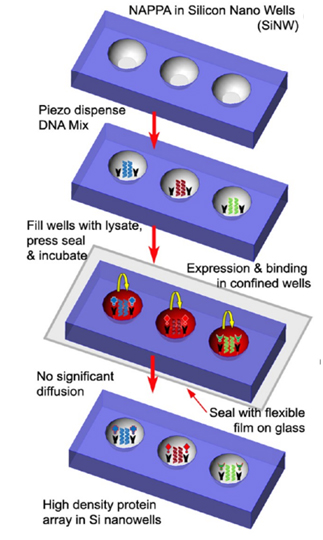LaBaer Lab | Home

High Throughput NAPPA Arrays
Team: Ji Qiu, Ph.D.
Collaborators: Peter Wiktor, Ph.D.(Center for Bioelectronics and Biosensors , Biodesign Institute) and Engineering Arts
Protein arrays provide a high-throughput platform that allows the assessment of protein functions and antigenicity in parallel. Our novel protein array platform has the following key advantages over other high-throughput systems to study proteins at the proteome level: 1) No need to purify proteins; 2) Displays full-length folded proteins; 3) Cost effective; 4) Multiplicity of tens of thousands proteins; 5) Flexibility of working with any set of proteins; 6) Proteins produced by relevant protein expression systems; and 7) Proteins produced at the time of experimentation, reducing the risk of loss of folding during manipulation. We currently print ~2,400 proteins per standard microscopic slide. We are currently developing even higher density protein arrays with the potential of printing >20,000 features in the same size format.
Our recent high density array development takes advantage of the mature semi-conductor etching technology to produce silicon substrates with tens of thousands of nano-volume wells. Companion developments include a piezo-dispensing arrayer that allows the precise and accurate dispensation of genes into individual nano-wells, a filling device that allows the dispatch of nanoliter volumes of protein expression lysate into each well, and a sealing method that completely seals each micro-well to eliminate any well-to-well cross talk.
We believe our platform, which provides extremely high density printing without diffusion or contamination between spots, will have a broad application in understanding protein functions.
Publications
Takulapalli BR, Qiu J, Magee DM, Kahn P, Brunner A, Barker K, Means S, Miersch S, Bian X, Mendoza A, Festa F, Syal K, Park JG, LaBaer J, and Wiktor P. High Density Diffusion-Free Nanowell Arrays. Journal of Proteome Research, 2012 Aug 3;11(8):4382-91. Epub 2012 Jul 13. PMID: 22742968 dx.doi.org/10.1021/pr300467q Abstract

